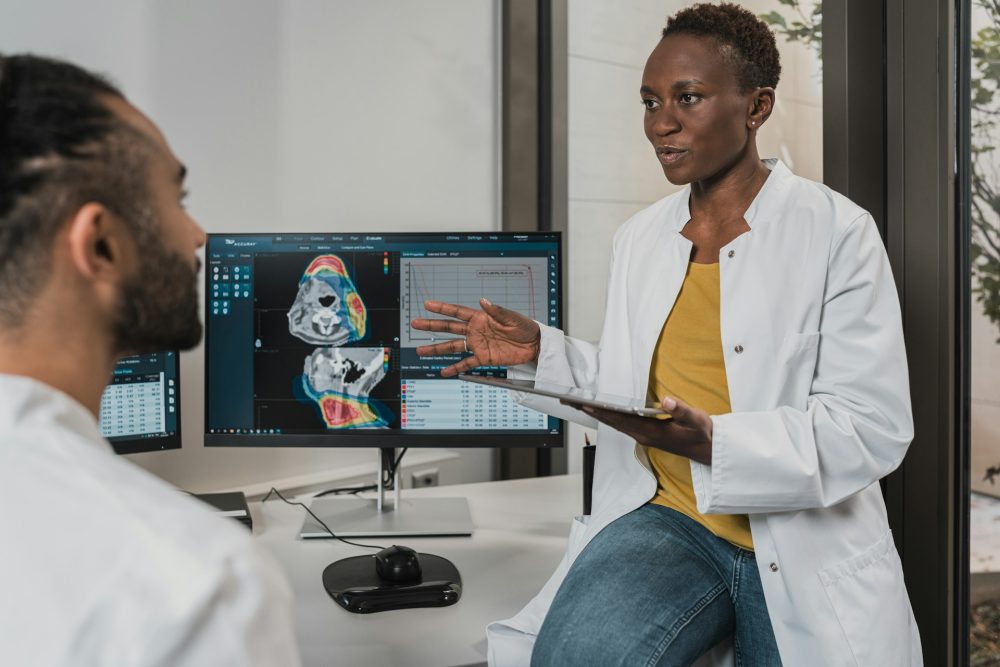Biotech
Delphi-2M: AI Model Predicts Multi-Disease Risks and Supports Precision Healthcare
Delphi-2M, a new AI model published in Nature, predicts risks for over 1,000 diseases using medical histories, trained on UK Biobank and validated in Denmark. It captures disease progression patterns, supports precision medicine, healthcare planning, and generates privacy-preserving data. Despite biases and limitations, it complements clinical practice and promises multimodal integration for future healthcare.

An international team of researchers has published in the journal Nature the results obtained from the development of Delphi-2M, an artificial intelligence (AI) model based on large-scale language architectures (LLM) capable of predicting the risk of more than 1,000 diseases based on an individual’s medical history.
The tool, trained with data from more than 400,000 participants in the UK Biobank and subsequently validated with records of almost two million people in Denmark, manages to estimate individual health trajectories with an accuracy comparable to or even superior to that of existing predictive models focused on specific pathologies.
The model introduces a key methodological innovation: it considers the temporal nature of multi-disease progression. Similar to how LLMs learn grammar and context from large volumes of text, Delphi-2M infers patterns of clinical progression by analyzing sequences of medical information.
According to its creators, this approach allows for simulating the cumulative burden of disease over up to two decades, opening the door to applications in both clinical settings and healthcare planning.
A prediction beyond a single disease
Delphi-2M consistently recapitulates the disease incidence patterns observed in the UK Biobank. Compared with risk models designed for single pathologies, Delphi-2M shows advantages in population-based prediction and comorbidity integration, making it a potentially useful tool for precision medicine.
In the analyses , AI was able to detect persistent clusters of comorbidities , such as mental health conditions, and quantify how certain pathologies alter life trajectory. Cancers were found to steadily increase mortality , while the impact of a heart attack or sepsis tends to recede after five years .
In addition to its predictive capabilities, Delphi-2M can generate synthetic data that preserves statistical patterns of co-occurrence without revealing personal information. This feature could be valuable for training new AI models in healthcare while minimizing privacy risks.
Limitations and cautions
Furthermore, the researchers also highlight several limitations. One of the main ones is the selection bias of the UK Biobank, known for its inclusion of mostly healthier volunteers than the population average. Furthermore, the heterogeneity of the data sources influenced some predictions, necessitating caution when extrapolating results to other healthcare systems.
Another limitation identified is that, although Delphi-2M detects variations in disease rates associated with family history or socioeconomic status, it did not show a clear trend in relation to lifestyle or year of birth, key factors in modern epidemiology.
For all these reasons, the authors insist that this technology should be considered as a complementary tool to clinical diagnosis , rather than as a substitute for current medical procedures.
Towards multimodal AI in health
One of Delphi-2M’s strengths is its transformer-based architecture, which facilitates the incorporation of new data layers. In the future, the model could integrate lifestyle information, blood biomarkers, prescription records, medical images, genomic data, or information obtained from wearable devices.
According to the authors, it is also plausible that similar models could be used to directly process unstructured clinical text , which would significantly expand their applicability. They even propose that Delphi-2M could serve as an accuracy module within clinical LLMs , reducing the tendency of these tools to generate inaccurate or “hallucinated” answers.
The study also identifies multiple use cases. Among them, it highlights support for medical decision-making , allowing for the identification of high-risk patients who could benefit from additional diagnostic testing or inclusion in screening programs before meeting conventional age criteria.
Another promising field is large-scale healthcare planning. By aggregating individual predictions, Delphi-2M could help project the expected disease burden at the local, regional, or national level, revealing in advance the communities with the greatest need for healthcare resources in the coming decades.
The authors acknowledge, however, that implementation in clinical practice will require a specific regulatory framework for AI in healthcare, an area still in its early stages of development.
From the scientific community, initial assessments highlight the potential of Delphi-2M, but also call for caution
Speaking to Science Media Centre UK, Gustavo Sudre, Professor of Genomic Neuroimaging and Artificial Intelligence at King’s College London, said the breakthrough represents “a significant step towards a form of predictive modeling in medicine that is scalable, interpretable, and, importantly, ethically responsible.” The researcher emphasizes that explainable AI is essential for clinical adoption and points to the future integration of data such as biomarkers, imaging, or genomics: “With these future integrations, the Delphi platform is well positioned to evolve into a truly multimodal precision medicine tool.”
Healthcare expert Peter Bannister, a member of the Institution of Engineering and Technology , highlights the validation of the model in two large national cohorts, but warns about biases in the data sets: “There is still a long way to go to improve healthcare, as the authors acknowledge that both data sets present biases in terms of age, ethnicity and current health outcomes.”
Bannister focuses on a more immediate challenge: ensuring that the necessary digital infrastructure and skills are available to all patients, regardless of their socioeconomic background. “The immediate challenge for healthcare is to ensure that currently available technologies can be offered to those most in need of improved access to treatment,” he emphasized.
The publication of Delphi-2M represents a step forward toward multi-disease predictive models capable of capturing the complexity of human health in scenarios of population aging and increasing comorbidity burden. Although the tool is still in the validation phase and faces significant limitations, its potential to support preventive medicine, healthcare planning, and biomedical research is evident.
As the authors themselves conclude, the ultimate goal is not to replace clinical work, but rather to offer evidence-based support and data integration that allows for anticipating needs, improving diagnostic accuracy, and optimizing resource distribution in the health systems of the future.
__
(Featured image by Accuray via Unsplash)
DISCLAIMER: This article was written by a third party contributor and does not reflect the opinion of Born2Invest, its management, staff or its associates. Please review our disclaimer for more information.
This article may include forward-looking statements. These forward-looking statements generally are identified by the words “believe,” “project,” “estimate,” “become,” “plan,” “will,” and similar expressions. These forward-looking statements involve known and unknown risks as well as uncertainties, including those discussed in the following cautionary statements and elsewhere in this article and on this site. Although the Company may believe that its expectations are based on reasonable assumptions, the actual results that the Company may achieve may differ materially from any forward-looking statements, which reflect the opinions of the management of the Company only as of the date hereof. Additionally, please make sure to read these important disclosures.
First published in GACETA MEDICA. A third-party contributor translated and adapted the article from the original. In case of discrepancy, the original will prevail.
Although we made reasonable efforts to provide accurate translations, some parts may be incorrect. Born2Invest assumes no responsibility for errors, omissions or ambiguities in the translations provided on this website. Any person or entity relying on translated content does so at their own risk. Born2Invest is not responsible for losses caused by such reliance on the accuracy or reliability of translated information. If you wish to report an error or inaccuracy in the translation, we encourage you to contact us.

-

 Impact Investing1 week ago
Impact Investing1 week agoEU Drops 2029 Gas Boilers Ban but Ends Incentives from 2025 in Shift Toward Cleaner Heating
-

 Impact Investing5 days ago
Impact Investing5 days agoEuropean Sustainability Week 2025: Advancing ESG Amid Uncertainty
-

 Crypto2 weeks ago
Crypto2 weeks agoTether Defends USDT After S&P Downgrade Amid Growing Calls for Transparency
-

 Fintech2 days ago
Fintech2 days agoArgentina’s Banks Poised to Integrate Cryptocurrencies, Paving Way for Widespread Adoption














